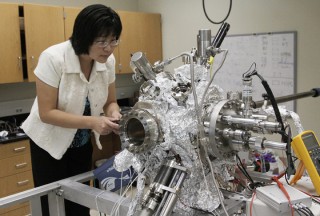
Matt Hellman | Lariat Photo Editor
By Robyn Sanders
Reporter
The Baylor department of physics is now able to image individual atoms using a Scanning Tunneling Microscope, under the direction of Dr. Zhenrong Zhang, assistant professor of physics.
“We never thought that we’d be able to individually image atoms,” Dr. Greg Benesh, professor and chair of the physics department, said.
Benesh said the microscope has a probe that moves along a surface and moves up and down according to the density of electronic charge of the atom or atoms.
“And so by putting together the up and down motion, then we can get an image of the surface on an atomic level,” Benesh said.
The lab is located in the “C” wing of the Baylor Sciences Building on the first floor. Zhang says the lab is in this part of the building because the instruments in the lab are sensitive to noise and vibration.
“I’m very thankful for the university to be able to provide the support and build a new lab in the ground floor,” Zhang said.
Dr. Zhang’s research will also examine the catalytic conversion of carbon dioxide to liquid fuel, as well as ways to produce alternative energy sources such as hydrogen.
“For now our focus is on titanium dioxide, which has a wide range of applications- photo catalytic applications, that is: UV light, or sunlight- to convert molecules to useful chemicals,” Zhang said. “That’s one of the properties that we’re interested in as well: to incorporate sunlight into useful energy. Titanium dioxide can also be used to clean up organic pollution, to convert the harmful organics into unharmful molecules.”
The microscope will also be able to examine different surfaces that speed up chemical reactions.
“We’re still trying to understand what it is about certain surfaces that makes these chemical reactions go faster,” Benesh said, “We’re trying to scrub pollutants out of emitted gasses as quickly as possible so that our atmosphere isn’t polluted.”
Zhang has two graduate students working in the lab, and two undergraduate students worked in the lab during the summer. She said that it’s a great opportunity for the students to conduct advanced research.
“I think that’s the best way to be able to engage them into science and to research, which is very important for the future, for the science and engineering area,” Zhang said. “They will receive the training on the most advanced nano-technology instrument, and it will be great for their future career. I think this is a really great opportunity for them to be able to really use this instrument.”
This summer, Zhang was able to obtain another Scanning Tunneling Microscope for the lab, which was purchased by Baylor. “This is another great opportunity,” she said.
“This will enlarge our opportunities to obtain external funding for research,” Zhang said. “So I think this is a great advantage now that we have two instruments and [it] will really increase our chance to get funded.”
Zhang said she has submitted research proposals to organizations such as the National Science Foundation and the Petroleum Research Fund in hopes of gaining funding.






